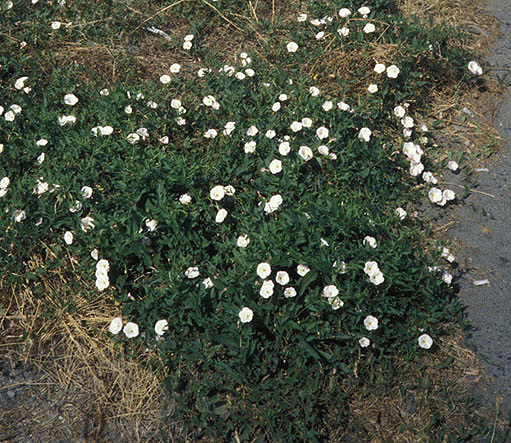
|
| Corn Bindweed; Convolvulus arvensis L. |
Bindweed Family; CONVOLVULACEÆ
|
| One would think hatred of weeds is elevated to a high art form, to hear or read the terrible exclamations engendered by
Seattle's morning-glories. They are made out to be quite villainous, covering without mercy every plant within reach. In July 1987 we
already featured the main terror of twiners, our commonest wild morning glory (Calystegia sepium, a.k.a Convolvulus
sepium). Now getting its due is its lesser cousin, which is can be quite charming in its reduced size, and petite, often pink, bell-like blossoms. |
| The name Convolvulus is derived from the Latin convolvere, meaning to entwine. The term arvensis means of the fields, that is, thriving in sunny, cultivated ground. "Corn" in the sense employed in the Old World, where this weed came from, refers to
what we call wheat. In other words, this is the "wild morning glory" weedy in European grain fields. |
| It is perennial from rambling starchy roots, the tops dying to the ground each winter, resprouting each spring. When I say
the roots ramble, it is with good reason: they can go 30 feet deep! It commences blossoming in May, and reaches its floral heyday in
July. Each flower is an inch or two wide, shallowly funnel-like, white, pink, or (usually) mixed. It is set off very prettily against the
deep blue-green foliage of arrowhead leaves. (In contrast, the Great Satan of our wild morning-glories makes usually white flowers,
far larger, against limp, dull, pale green foliage of a much coarser texture.) |
| No soil is too dry or site too sunny and hot for Corn Bindweed. It would make a swell drought-tolerant garden ornamental
if it would sit still. But no, it insists on conquering the place. Each stem trails itself along the ground or wraps itself around
something, and the whole plant merrily twines along, around or over whatever it encounters. |
| If you are infested with either this or its "big brother" you have several options. Do nothing is one, whereupon
gradually your garden is eaten alive. Pull it out halfheartedly, now and then, in which case you are in for endless work. Pluck every piece
seen, religiously, for at least three years to starve it to death. Spray it with Roundup or some similar herbicide, thus spoiling your
spotless organic principles. I have done all three. In fact I still am battling it in my immediate neighbors' yards, because their approach
will never get the job done. |
The plant has some other English names, which serve well to summarize its attributes and the emotions it calls forth:
Lesser Bindweed, Devil's Guts, Creeping Jenny, Bearbind, Ropebind, Cornbind, and Small-Flowered Morning Glory.
|
Originally published as the Seattle Tilth newsletter Weed of the Month in September 1994, along with an illustration from a book.
Back |
|
|

